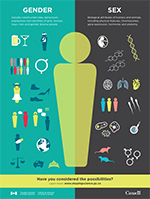“Advertising takes what already exists and by concentrating it and privileging it in the culture (and ignoring other things) it creates new meanings of gender.” (The Codes of Gender: Identity and Performance in Pop Culture by Sut Jhally)
Social Constructions of Gender
The codes of gender as a film examines the differences between sex and gender. Sex a biological attribute that assigns female or male when we are born. Gender on the other hand is a social, cultural phenomenon and gender identity is largely tied to what culture you were born into. Although, western European cultures have been only two sex/two gender however it is shown to be a cultural phenomon since countries such as India have more than two offical sexes.
Furthermore, the film analyzes how historically and now how
advertisements reproduce the codes of gender by subtly that we would view as normal. The differences in how women's hands are shown in an advertisement either caressing an object or the object simply existing in their hands. The light touch of women's hands are to code the audience into normalizing the soft touch of a woman, and the inherently defenselessness, submissness. Whereas, when men hold products it is with a strong, assertive grasp the illuminates the power of masculinity. Foucault would view the sense of power advertisements have on the general soceity as it normalizes gender codes and establishes power hierarchies of men and women or producer and consumer. Within the poses of everyday media and advertisements the There is power within knowing where subtle gender codes persist in media. From the small ways in which women are posed laying down, dazed, loss of control of emotions, and the self embracing touch that is reproduced in almost every picture continues to normalize how society views women and femininity.
Women are gaining more and more agency and have been seen in powerful roles in society. However, even within these powerful roles there are still hints of gender roles that persist. Female superheros almost always have skimpy outfits compared to the male supers, and are still sexualized to a high degree. Such as Harley Quinn in the Suicide Squad series. There is always sexualization that happens to women characters. I would say that women now have agency to take back their sexuality and not dress or pose for the male gaze. With societal changes there are more and more people who read authors like Foucault and break away from commercial realism to question the inherent "normalness" of advertisements or media.





I think you did a great job taking visual codes further when describing the differences between male and female superheroes. I mean, there are barely any female superheroes to begin with, compared to male! I would argue that there has not yet been significant change in this field yet. In the few female superheroes we see, at least on screen, you'd be hard pressed to find one dressed similarly to the male heroes. There is still a lot of societal change that would have to occur there. Other than that, I agree with all of your points. Great post!
ReplyDeleteHey Jenna! This was an interesting read. I definitely agree with you with how much female superheroes get sexualized. Harley Quinn was a great example just due to the immediate dichotomy you can see between her and the rest of the cast. From just a gut reaction, I would say there's still a lot more to be done in media, but I do think we are at least moving in the right direction.
ReplyDelete